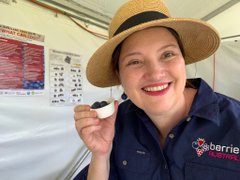- PROJECT NAME
- Port Augusta QFly SIT factory pilot operation
SITplus: Port Augusta QFLY SIT factory pilot operation (core services)
- PROJECT CODE
- FF18003
- DELIVERY PARTNER
- University of Western Sydney
Primary Industries and Regions South Australia (PIRSA)
- PROJECT LEAD
- Markus Riegler
m.riegler@westernsydney.edu.auWill Zacharin
will.zacharin@sa.gov.au
PROJECT DESCRIPTION
A purpose-built sterile Queensland fruit fly facility was established in Port Augusta, South Australia under earlier work in the Hort Frontiers Fruit Fly Fund and broader SITplus initiative. With sterile insect technology (SIT) a promising control method for Queensland fruit fly, the facility is a state-of-the-art factory for the mass-rearing of sterile flies.
From 2019 to 2023, this investment supported the facility to consistently produce up to 25 million sterile pupae per week (current facility maximum capacity). The key focus was to refine existing standard operating procedures to ensure the highest possible number of fit for purpose, healthy Qfly are produced in the most financially economical way.
Initial work focused on the development of sustainable and innovative production practices, to maximise the production capabilities of the factory. Modification of equipment developed overseas for rearing Med Fly and the development of completely new cages/towers has allowed the production process to be streamlined and to specifically suit Qfly. The key staff members in the facility now have experience which covers all aspects of the commercial production of Qfly, from day-to-day procedures to managing production teams, and have been active participants in the planning and expansion of the existing fruit fly culture in the facility.
Sterile flies were dispatched to rear out centers in Yanco (NSW) and Tatura (VIC) for experimental release efforts, to Queensland Department of Agriculture and Fisheries to assess efficacy of IR colour pupal sorting equipment and to SARDI, Adelaide for insecticidal bait efficacy trials. Many hundreds of millions of sterile flies were also dispatched to rear out centers in Netley and Renmark (SA) for use in outbreak responses in both metropolitan Adelaide and in the Riverland (SA), as well as to assist outbreak response in Perth, WA.
The eradication of Qflies has now been achieved in Perth WA, and Metropolitan Adelaide in 2021, largely due to multiple releases of sterile flies. Numerous Qfly outbreaks across the Riverland Pest Free Area since 2021 have required the ongoing use of SIT flies mainly via aerial releases. Such is the reliance of South Australia on the supply of sterile Qflies, that the current facility production area is being doubled, to meet both regional and federal fly requirements.
Research conducted on the pathogen load revealed that Qfly, including the Qfly strain at the factory, have covert persistent infections with three fruit-fly specific RNA viruses (cripavirus, iflavirus, sigmavirus); they are related to other insect-specific viruses with considerable host fitness effects. We assessed key parameters important to their epidemiology such as transmission mode, viral loads across host development and tissues, as well as host effects in Qfly. Two of the viruses (iflavirus and sigmavirus) are vertically transmitted (mostly maternal) while cripavirus is horizontally transmitted. The viruses do not have apparent acute effects in persistently infected flies kept at standard laboratory conditions, however they still affect overall fitness and performance of infected lines. Importantly, we found that the viruses cause acute infections that result in mortality when infecting previously uninfected flies, or when persistently infected flies are exposed to stressful conditions. We have developed diagnostic tools to monitor these viruses in fly populations and strategies that allow effective virus removal from infected laboratory populations.




